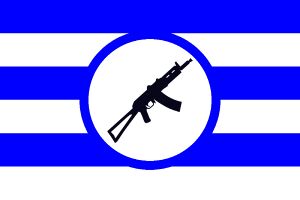The Second Republic of Malorian Islands
The Second Republic of Malorian Islands | |
|---|---|
| 1944–1947 | |
|
Flag | |
| Motto: "Une Nation Juste et Equitable" | |
 | |
| Capital and | St. Bernard |
| Official languages | French, English |
| Recognised national languages | French, English |
| Recognised regional languages | Spanish and Haitian |
| Ethnic groups (1946) | White (82%), Black (13%), Asian (2.5%), Hispanic (2.5%) |
| Demonym(s) | Malorianese |
| Government | Provisional government |
• President | Veronique LeMonde |
| Legislature | The Council of The Republic |
| The National Senate | |
| The House of Representatives | |
| Foundation Malorianese Civil War | |
| Historical era | Malorianese Civil War |
• Return of President | April 19th, 1944 |
• New constitution written | June 2nd, 1944 |
• Government dissolved | April 30th, 1947 |
• Established | 1944 |
• Disestablished | 1947 |
| Today part of | |
History
The Second Republic of the Malorian Islands (1944-1947)
After the end of World War II, the country faced near economic collapse as the economy was weakened due to France and Germany took advantage of the Malorian Islands' national goods and supplies. LeMonde and her social democratic government failed to successfully implement economic and social reforms that would've fixed the issues that were facing the Malorian Islands as of 1947.
The Malorianese Civil War (1945-1948)
The failed economic and social reforms of the LeMonde government forced the left-wing rebel group, the Malorianese Popular Front, to re-form under the leadership of Evan Gonzales. The Marxist rebel leader and his army, supported by the Soviet Union and Yugoslavia, fought the Malorianese National Guard aggressively between late 1945 and early 1947. LeMonde's government began to crack under pressure as some elements of the population rioted against the government in Freedom Square within St. Bernard. Knowing that the end was near, LeMonde and her government invited the higher echelons of the Malorianese Popular Front to peace talks between the rebel group and the LeMonde government with the end result being the eventual MPF's introduction into the Council of the Republic before eventually seizing power altogether on February 28th, 1947. The coup d'etat against the LeMonde marked the end of the Second Republic of the Malorian Islands and the LeMonde Administration. Some sections of the Malorianese Armed Forces that were not loyal to Gonzales still fought against Gonzales' government as late as mid-1948 until a ceasefire was created to end the civil war.
The Collapse of the Second Republic of the Malorian Islands
In early 1947, LeMonde relinquished power and allowed Gonzales and the Malorianese Popular Front to take power in the Malorian Islands. LeMonde lived in seclusion after her fall from power, eventually dying in a small village not far from Bordeaux in 1956.


